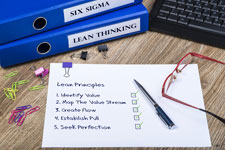How to Improve your Processes with Lean Six Sigma
By Joan Martino
What if the flow-through of products in your operations was on-time, in-full, and had no errors or in-conformities ever? Is that even possible?
Many factors affect production and no matter how many checks and balances we have in place, errors still occur. Is there a system or methodology that can help improve this? There are many options available, and no one system is fool proof. We do see a lot of promise in the discipline of Lean Six Sigma, however.
Lean Six Sigma is a process improvement methodology focused on providing value to the customer through data and fact-driven business decisions that eliminate waste and optimize resources. The Voice of the Customer, the Voice of the Business and the Voice of the Employee form foundations for projects that are customer-, profit- and process-driven, and are critical to quality.
Effectiveness and Efficiency: A Powerful Combination.
One of the key differentiators in the Six Sigma process lies in training and developing a skillful team that takes responsibility for process improvement and strategic goals. There must be top management support, cross-functional team participation and credited experiential learning. Six Sigma projects are led by employees who have earned and demonstrated their knowledge by providing value to customers. Wow – employee training that is a business process linked to strategic goals and performance criteria!
While achieving a Six Sigma process becomes the highest goal, lower success rates can also produce significant operational efficiencies, yielding lower costs and increased customer satisfaction.
Lean Six Sigma isn’t new. Motorola pioneered the concept of Six Sigma during the mid-1980s as an approach to measuring product and service quality. Then AlliedSignal applied the concepts and demonstrated a direct correlation with Six Sigma projects and earnings per share. Once GE and Jack Welsh grabbed it, the rest is history. Companies soon realized that the integration of Six Sigma and Lean Enterprise methods resulted in gains in productivity and profit. When Kraft Foods implemented Lean Six Sigma processes in manufacturing a few years ago they saw a substantial increase in productivity and an improvement of over 10% in the company’s production capacity. Lean Six Sigma is recognized by many industries including Food and Beverage, Retail, Hospitality, Healthcare, Financial Institutions and more. In fact, there are hundreds of recent job postings that call for skills and certification in Lean Six Sigma.
A Problem-Solving Methodology
The fundamentals of Six Sigma are centred around a simple problem solving methodology: DMAIC (Define, Measure, Analyze, Improve and Control). The term “Six Sigma” is based on a statistical measure that equates to 3.4 or fewer errors or defects per million opportunities. While achieving a Six Sigma process becomes the highest goal, lower success rates can also produce significant operational efficiencies, yielding lower costs and increased customer satisfaction.
Is set-up or change-over in production taking too long resulting in lost production and capacity? Most processes don’t have the luxury of continuous production; down time is non-production time and it is measured from the end of the last value-added step in the original production process to the start of the first value-added step for the next process. Since there are many different types of changeovers, selecting the one that occurs most frequently and has the most complexity may be the best place to start. In a service industry this may be the time between shifts or services. In the beginning it is important to determine a baseline by capturing the average time for changeover. Here are some things to consider:
-
- Who is involved; operators, supervisors, process engineers, maintenance, quality assurance
-
- How communication is conducted; instructions, checklists, informing all parties
-
- What equipment and supplies are required
This provides the foundation to define the problem, determine the customer requirements and start the process.
Next, it is important to identify the gaps between what is occurring and what should be occurring. Observe and capture data on all the important details that are missed including pre- and post-changeover work and measure the current performance. This stage is quite revealing and provides insight into process capability and where things are failing. In the Lean Six Sigma approach there are various tools used to measure and identify issues and variables.
Once there is sufficient information on the key variables affecting the process it’s time to analyze all the data and separate the “vital few” from the “trivial many.” The Six Sigma approach uses models, statistics and analytical tools to provide a data driven approach to solving problems. In service industries this area is often centred on qualitative, rather than quantitative analysis.
Lean and Six Sigma methodologies work best when combined to improve the process. Simple things like preparation, standardizing, visual workflow and operator skills training all contribute to its success.
In order for continuous improvement to be sustainable a control system to validate processes and verify capability long-term must be in place. In this phase the new methods and improvements are adopted and deployed across the business. Training, coaching and follow-up checks keep problems from recurring.
Improvement projects can be easily identified in most workplaces. Lean Six Sigma and the DMAIC problem solving methodology identifies breakthrough performance opportunities as opposed to incremental improvements and can lead to a significant impact on the organization’s financial statement.
About the Author
Joan Martino is CEO of Quality Supply Chain, a company that provides simplified solutions to address regulatory compliance, supply chain initiatives and audit requirements for multiple industry sectors including food manufacturers, hospitality, retail, warehousing, packaging and equipment suppliers. She has also helped many leading US and Canadian companies integrate their systems with HACCP and GFSI requirements.

-
 Supply Chain Management
Building a Safer Food System with Smart Supply Chain Strategies
Supply Chain Management
Building a Safer Food System with Smart Supply Chain Strategies
-
 Supply Chain Management
Driving Food Safety: The Role of Transportation Management Systems
Supply Chain Management
Driving Food Safety: The Role of Transportation Management Systems
- Podcast How Blockchain is Transforming the Food Industry: Perspectives from Ali Asgar Abbas, Co-Founder of ProofEasy
-
 Food Safety
The Realities of IPM: Challenges and Solutions for Pest Prevention in Food Safety
Food Safety
The Realities of IPM: Challenges and Solutions for Pest Prevention in Food Safety
- Podcast How Advanced Inspection Technology Can Transform Food Safety: Perspectives from Kye Luker
-
 FeaturedPublic Health
The Silent Invader: Uncovering H. pylori and Its Harmful Risks, Including Foodborne Illness
FeaturedPublic Health
The Silent Invader: Uncovering H. pylori and Its Harmful Risks, Including Foodborne Illness




